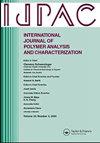菠萝木屑填充聚酯复合材料介电和热行为的有限元分析
IF 1.6
4区 工程技术
Q4 POLYMER SCIENCE
International Journal of Polymer Analysis and Characterization
Pub Date : 2025-05-15
DOI:10.1080/1023666X.2025.2496319
引用次数: 0
摘要
本文采用有限元法和实验分析方法研究了菠萝木粉(PWD)填充聚合物复合材料的介电和热特性。用不同重量(0-25 wt)的聚酯树脂增强PWD。%)和音量(0-17.95卷。%)百分比。导热性测试根据ASTM E-1530在Unitherm™2022模型中进行,而介电性能则借助HP LCR阻抗分析仪和HP 16451B介电测试仪进行测试。实验结果表明,加入17.95 vol后,聚酯树脂的导热系数由0.342降至0.245 W/m-K。% PWD,确保了增强的隔热性能。此外,利用Digimat软件模拟的有限元分析所得的导热系数值与实验值吻合较好,误差在1% ~ 10%之间。实验结果表明,随着PWD载荷的增加,导热系数值降低,从而保证了保温性能的增强。此外,利用Digimat软件模拟的有限元分析所得的导热系数值与实验值吻合较好。有限元分析还表明,加入PWD颗粒后,热流密度有所降低。复合材料的介电常数在频率较低时较高,随着频率的增加而降低,这可以归因于不同的极化机制。随着25 wt的加入,聚酯树脂的介电常数也逐渐增大。% PWD填料含量从1.4到2.7在1mhz频率。本文章由计算机程序翻译,如有差异,请以英文原文为准。
Dielectric and thermal behavior analysis of polyester composites filled with pineapple wood dust using finite element method
This study examines the dielectric and thermal characterization of pineapple wood dust (PWD)-filled polymer composites using the finite element method and experimental analysis. PWD was reinforced with polyester resin with different weight (0–25 wt. %) and volume (0–17.95 vol. %) percentages. Thermal conductivity tests were conducted as per the ASTM E-1530 in a Unitherm™ 2022 model, whereas the dielectric properties were tested with the help of an HP LCR impedance analyzer and an HP 16451B dielectric tester. The experimental result showed a decrease in thermal conductivity values of polyester resin from 0.342 to 0.245 W/m-K with the inclusion of 17.95 vol. % PWD, which ensured enhanced thermal insulation. Further, the thermal conductivity values obtained from finite element analysis simulated using Digimat software were in good agreement with experimental values, and the error lies in between 1% and 10%. The experimental result showed a decrease in thermal conductivity values with increased PWD loading, which ensured enhanced thermal insulation. Further, the thermal conductivity values obtained from finite element analysis simulated using Digimat software were in good agreement with experimental values. The finite element analysis also revealed a decrease in heat flux density with the addition of PWD particles. The dielectric constant of the composites was found to be higher at lower frequencies and decreased with increasing frequency, which can be attributed to various polarization mechanisms. The dielectric constant of polyester resin also increased gradually with the addition of 25 wt. % PWD filler content from 1.4 to 2.7 at 1 MHz frequency.
求助全文
通过发布文献求助,成功后即可免费获取论文全文。
去求助
来源期刊
CiteScore
3.50
自引率
5.30%
发文量
37
审稿时长
1.6 months
期刊介绍:
The scope of the journal is to publish original contributions and reviews on studies, methodologies, instrumentation, and applications involving the analysis and characterization of polymers and polymeric-based materials, including synthetic polymers, blends, composites, fibers, coatings, supramolecular structures, polysaccharides, and biopolymers. The Journal will accept papers and review articles on the following topics and research areas involving fundamental and applied studies of polymer analysis and characterization:
Characterization and analysis of new and existing polymers and polymeric-based materials.
Design and evaluation of analytical instrumentation and physical testing equipment.
Determination of molecular weight, size, conformation, branching, cross-linking, chemical structure, and sequence distribution.
Using separation, spectroscopic, and scattering techniques.
Surface characterization of polymeric materials.
Measurement of solution and bulk properties and behavior of polymers.
Studies involving structure-property-processing relationships, and polymer aging.
Analysis of oligomeric materials.
Analysis of polymer additives and decomposition products.

 求助内容:
求助内容: 应助结果提醒方式:
应助结果提醒方式:


